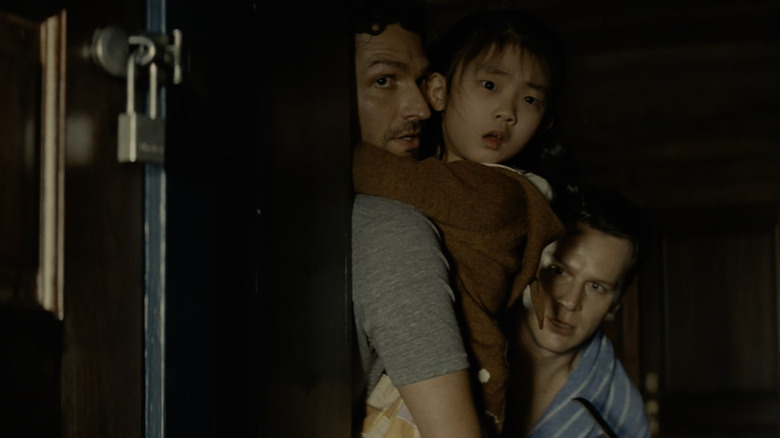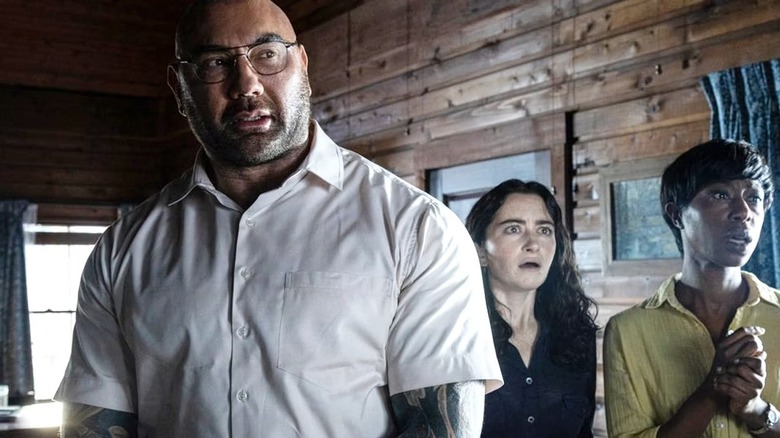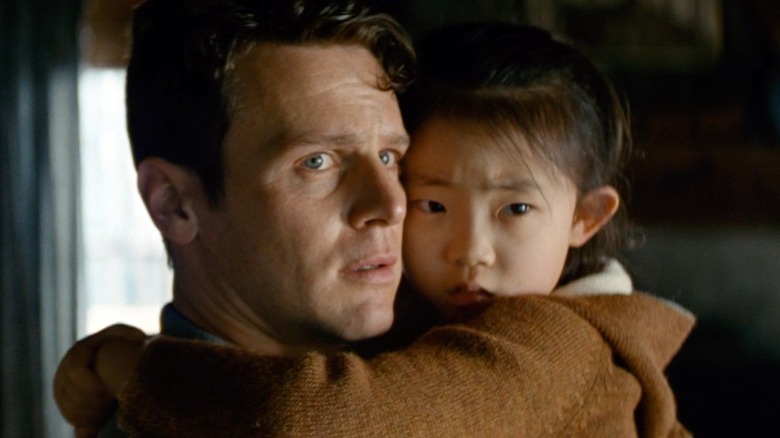M. Night Shyamalan Still Prefers The 'Danger' And 'Limitation' Of Shooting On Film
Ever since the success of "The Visit," M. Night Shyamalan has entered a wonderful return to form, stepping away from his lofty blockbuster fare and focusing on lower-budget, back-to-basics thrillers. Next month, Shyamalan continues to further his unique skill of building atmosphere and suspense with "Knock at the Cabin." Based on the novel, "The Cabin at the End of the World," by Paul Tremblay, the film follows two dads (Jonathan Groff, Ben Alridge) and their daughter (Kristen Cui) who find themselves hostage by a group of mysterious doomsday theorists while on a family vacation.
Continuing his momentum from 2021's "Old," Shyamalan also shot his newest film on 35mm and '90 school lenses — moving away from his switch to digital ever since "After Earth."
In the January 2023 issue of Total Film Magazine, Shyamalan explained why he still prefers the unpredictable nature of shooting on film:
"I prefer the feeling of film. I don't know, we could theorise about why film is significantly different than watching a digital camera. Maybe it's that it's an organic chemical process that's involved with it. It's organic things that are making these images, and you feel that life in it. The way its limitations represent light and colour and skin tone and nature — maybe it resonates more for us. I do believe that the limits to film are what makes it so incredibly beautiful . Even ourselves, how we're taking in the world, is a facsimile. In reality, there's a centre of our eye that's actually dark. There's a dark spot, and we're filling it in with imagination. There's nothing there. This is a representation of what we're seeing, and maybe film evokes our human experience more.
Shyamalan excels under limitations
It's interesting that Shyamalan describes the nature of film and its subjectivity as a "limitation" versus the sheen of digital film. Shyamalan has always been an ambitious filmmaker, even if those ambitions don't always pay off or shape a coherent vision, he has always done his best work under some level of "limitation."
Unfortunately, after delivering some box-office bombs over his career, many studios weren't willing to work with Shyamalan — leading the director to find alternate solutions. The films that are responsible for shaping the latest "revival phase" of his career, "The Visit," "Split," and "Glass" were all self-financed, presenting Shyamalan with a challenge to balance the loftier parts of his creative vision with stretching his money as much as possible.
To Shyamalan, there's a certain sense of "danger" and "urgency" that comes with shooting on filmstock, where every moment captured on film feels much more valuable than the disposable nature of digital memory:
"I also love the limitation of rolling film, and what it does to everyone [on set], and the danger of that — "OK, we're rolling film. Here we go." And it's [imitates whirring noise], and the camera starts, and the actors take their place. It's something that's going to get captured on this chemical substance only this one time. It's so precious. That emotion that's coming out of them is so beautiful and singular. That's it, that's the only time we'll be there. And I hope the camera's catching it, and exposing the light in the right way. There's so much danger involved in it. I love it."
Beauty in distortion and imperfection
Though Shyamalan doesn't consider his films "horror" per se, his style is known for its surrealistic quality that shooting on 35mm helps him achieve in spades. Though his follow-ups, "Split," and "Glass" were shot on digital with the Arri Alexa and are still great-looking films, there is still a sense of sterility that distinctly separates those films from the original "Unbreakable."
As Shyamalan tries to recapture the experience of the "Shyamalan thriller" for his loyal and newer audiences, it makes sense for him to return to the grainy imperfections and light-distorting wonder of celluloid. It's also obvious that he has a genuine passion for it and its function in visual storytelling.
"There's beauty and limitation in the way it distorts the reality, you know? It isn't a computer deciding it. It's the actual ground-glass that's causing it to be a little soft on the edges, or causing the light to flare in that way, or its depth of field is wonky. Let's say you use an old zoom, and as you're zooming, the focus is not even and correct. And so you're fighting it. And what are you (the viewer] feeling? You're actually feeling a human being who's trying to focus. You're feeling another human being there who's bringing life and breathing as he's trying to get the eyes in focus. All of these things are subconsciously bringing a kind of life to the piece that makes it alive."
"Knock at the Cabin" arrives in theaters on February 3, 2023.


